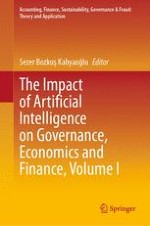2021 | OriginalPaper | Buchkapitel
5. The Impact of Artificial Intelligence on Central Banking and Monetary Policies
verfasst von : Hakan Kahyaoglu
Erschienen in: The Impact of Artificial Intelligence on Governance, Economics and Finance, Volume I
Verlag: Springer Nature Singapore
Aktivieren Sie unsere intelligente Suche, um passende Fachinhalte oder Patente zu finden.
Wählen Sie Textabschnitte aus um mit Künstlicher Intelligenz passenden Patente zu finden. powered by
Markieren Sie Textabschnitte, um KI-gestützt weitere passende Inhalte zu finden. powered by
